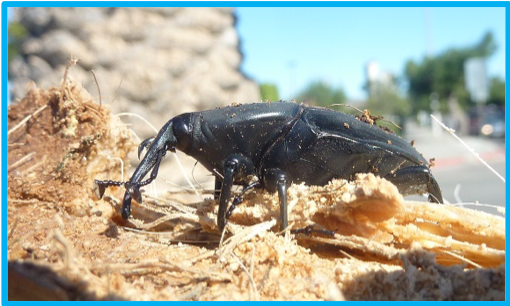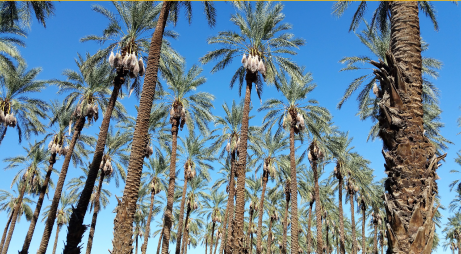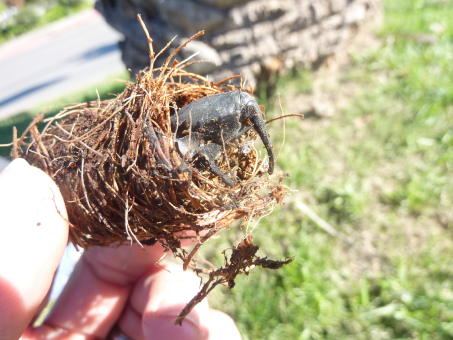Battling the South American Palm Weevil Invasion in California

By Leah Taylor
The South American Palm Weevil (SAPW)(Rhynchophorus palmarum) continues to pester the Golden State and is posing a significant threat to California's iconic palm tree population.
Native to tropical regions of South and Central America, the SAPW has a particular affinity for palm species including the majestic Canary Islands date palm and edible date palms that adorn California's landscapes. The female lays eggs in the palm’s crown where the larvae subsequently feed on the tree's apical meristem or palm heart, leading to almost certain decline and death of the tree.
The devastating effect of this invasive species is particularly alarming in San Diego County. Palm-lined streets contribute significantly to the tourism in our city, palms thrive in our landscape designs, and provide shelter for diverse species of birds and animals. Further, the state's agriculture relies on palms, with the date palm industry being a notable economic contributor.

Date palms with netting over fruit to protect from insects.
The discovery of the SAPW in San Ysidro in 2011 raised concerns about its potential economic and environmental consequences. Efforts have been underway from many agencies, but there is not a current quarantine to help control the spread of this pest as it slowly encroaches north through San Diego County. Adult South American Palm Weevils are strong fliers but have been shown to disperse slowly, possibly due to the abundance of habitable host palms. It is possible that long-distance flights could occur through areas lacking in suitable hosts, posing significant risk to the date palm industry in Coachella Valley, north of San Diego.
One challenge in combating the SAPW is its ability to go undetected until significant damage has occurred. Early detection is crucial for effective control, and experts are urging Californians to be vigilant and report any signs of infestation to the Center for Invasive Species Research at UC Riverside (https://cisr.ucr.edu/). Mature palms show signs of infestation starting at the crown. Look for fronds that are collapsed into an umbrella shape, notching in the fronds, and fallen fronds with holes chewed through. Although damage to the tree itself is usually more noticeable, be on the lookout for adult weevils too. They are deep black in color, measure nearly two inches long, and identifiable long weevil snout, or rostrum. Female weevils use their long rostrums to create access wounds in the palm tissue to deposit their eggs. The male Weevils are readily distinguished from the females by the presence of a “comb” of hairs on the rostrum. Their pupal cocoons are made from tough palm fibers that the weevils wrap around themselves after eating away the palm’s soft tissues and can often be seen on the ground around infested trees. While not yet found in California, female palm weevils vector the pathogen Bursaphelenchus cocophilus, commonly known as red ring nematode (RRN). Trees infected with RRN typically die within a few months or less.

Emerging South American Palm weevil from cocoon.
Several initiatives are being implemented to control the spread of the SAPW including increased monitoring of palm tree populations, public awareness campaigns, and the development of targeted insecticides. Research is underway to identify new control methods with insect traps and natural predators.
Local communities are also getting involved in the fight against the South American Palm Weevil, hoping to avoid very costly tree removals. Not removing a dead or dying tree can increase the risk of injury or even death when damaged fronds fall or the entire crown breaks off. Protecting a healthy palm is possible with help from a certified pesticide applicator who will preemptively treat the tree with appropriate insecticides. To remain effective, healthy non-infested trees must be re-treated every few months which can be an option to protect high-value trees. “A weevil infestation is a death sentence for the palm. These insects have 100% kill rate in three to six months, unless the tree is treated very aggressively. Even treatment may not be enough to save an infected palm,” Dr. Mark Hoddle, UCR, mentioned in a recent publication.
As California battles this destructive pest, government agencies, researchers, communities, and residents must work together to implement effective strategies for early detection, control, and prevention. The future of California's iconic palm trees depends on the proactive measures we take today. To learn more about the South American Palm Weevil and how you can help prevent its spread, visit https://cisr.ucr.edu/invasive-species/south-american-palm-weevil.
Leah Taylor is the UC Master Gardener Program Coordinator and previous staff research associate with the University of California.

